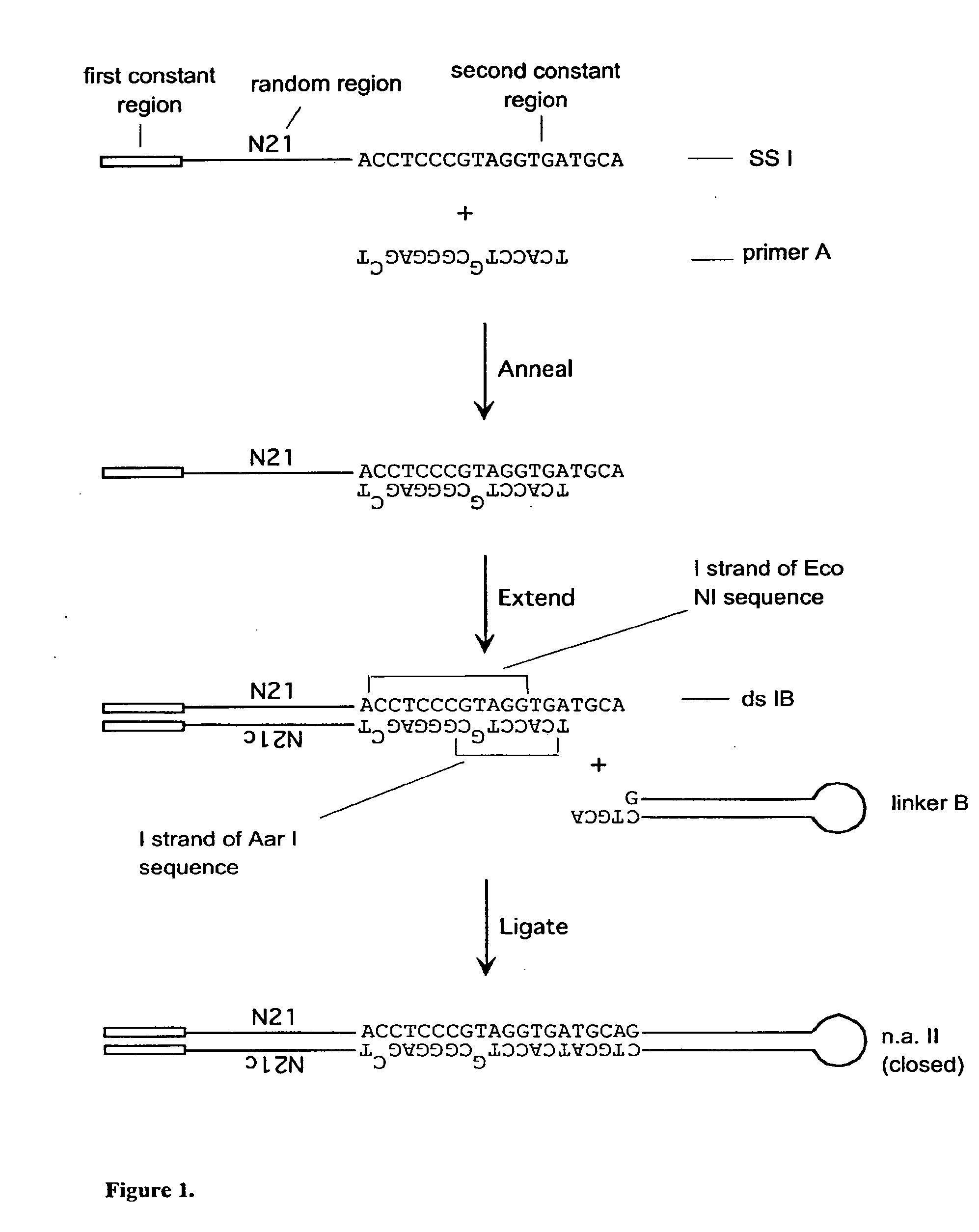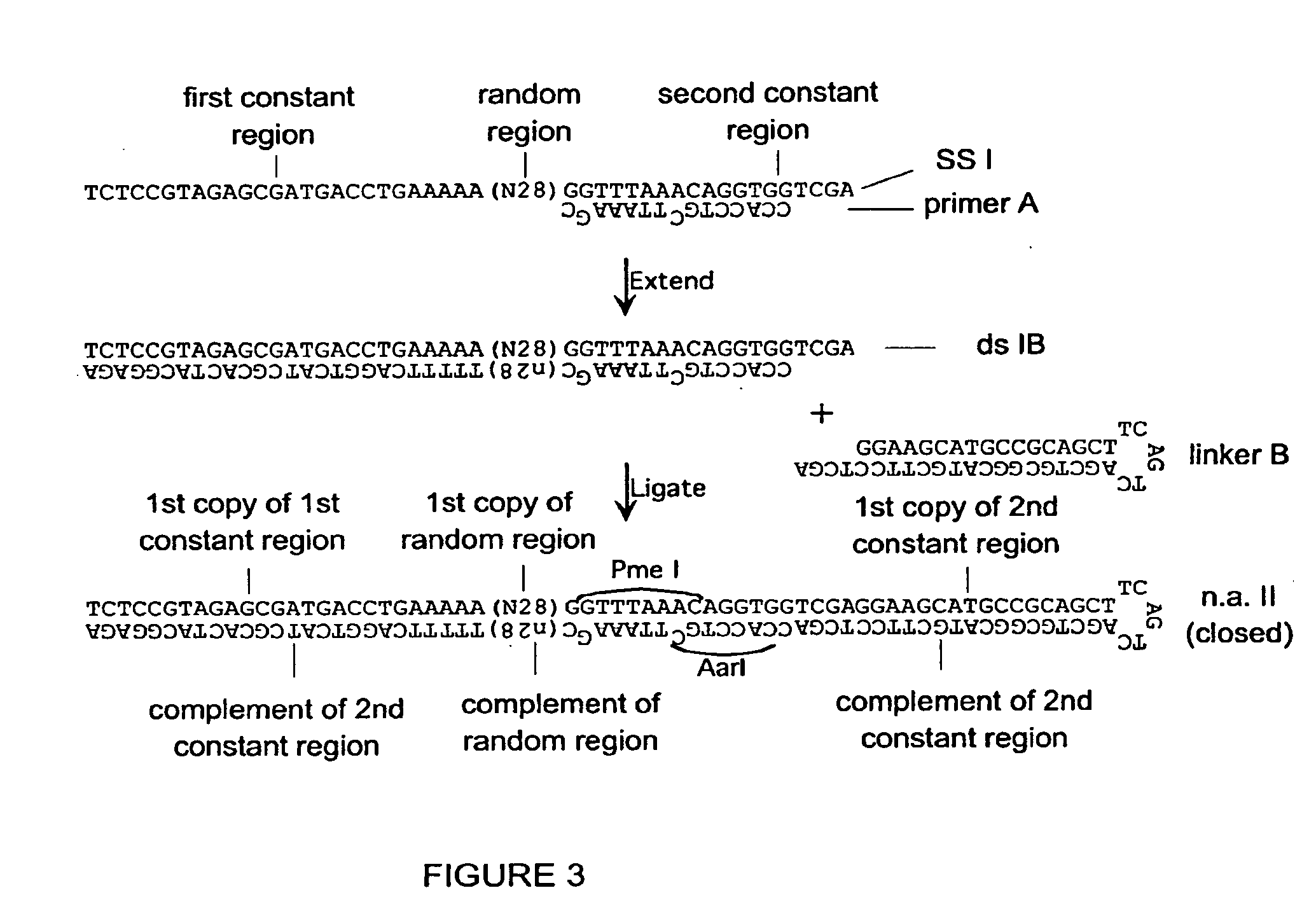RANDOM RNAi LIBRARIES, METHODS OF GENERATING SAME, AND SCREENING METHODS UTILIZING SAME
a technology of ribonucleic acid and expression vector, which is applied in the field of random rnai libraries, can solve the problems of difficult synthesizing and unsuitability for rnai applications, and achieve the effect of inhibiting or preventing the ability of a virus to replicate in a subj
- Summary
- Abstract
- Description
- Claims
- Application Information
AI Technical Summary
Benefits of technology
Problems solved by technology
Method used
Image
Examples
example 1
Dual RNAi Expression by a Retroviral Vector
[0283]A retroviral vector was designed to express simultaneously two shRNAs. The vector contained enhanced, farnesylated green-fluorescent protein (eGFPf), which allows straightforward flow-sorting of infected or transfected cells, and a G418 resistance gene, which facilitates selection of infected or transfected cells. The eGFP gene of the retroviral vector pQCXIX® (Clontech) was replaced with eGFPf, and two copies of a Pol III-dependent H1-promoter cassette (from pSuper-Retro) were cloned into the inactivated long-terminal repeat of pQCXIX, to create the vector pQe2. In each H1-promoter cassette of pQe2, 2 unique restriction enzyme sites were incorporated to allow independent cloning of shRNA constructs into each cassette. pQe2 was used to knock down expression of proteins important in spindle-checkpoint function; both shRNA knockdown (by Western and other analyses) and eGFP expression have been validated. FIG. 12 depicts flow-cytometric ...
example 2
Vector Modification
[0284]pSuper-Retro (Oligoengine®, Seattle, Wash.), which can be packaged as a retrovirus and includes the gene encoding enhanced green fluorescent protein (eGFP) and a G418-resistance gene, was used in the cloning methods below. The Bgl II-Mlu I fragment of the spacer sequence was replaced with a Bgl II-Bbs I-Mlu I fragment. By then cutting with Bbs I, filling in with Klenow, and cutting with Not I, the linearized vector depicted in FIG. 5 was created. Other than Pme I, which was eliminated in creating the spacer sequence, pSuper-Retro lacked all the relevant restriction enzyme sites needed for the procedure shown in FIGS. 6-8, and thus was suitable for the procedure.
[0285]In the development of alternate vectors, the Bgl II cloning site and the spacer sequence between Bgl II and Hind III of pSuper-Retro were replaced with Xcm I and Sfi I to eliminate the unique Pme I site. (The region from just before the Bgl II site back to the unique BlpI site was PCR amplified,...
example 3
Creation of a Library of Partially Self-Complementary RNA Molecules
[0287]A set of single-stranded (ss) DNA molecules was obtained, comprising, from 5′ to 3′, a first constant region (“N21”), followed by a region of random sequence, in this embodiment a random sequence of 21 nucleotides (nt), followed by a second constant region containing 1 strand of a site of a first restriction enzyme (in this case EcoNI). A representation of a single ss molecule from the set is depicted in FIG. 1 as “ssI,” also referred to herein as “single-stranded nucleic acid intermediate I.” A primer mismatched at two positions (“primer A” in FIG. 1) was annealed to the oligo, such that the complementary strand, when in double-stranded form, was a substrate for a second restriction enzyme (in this case AarI), but not the first restriction enzyme, as depicted in FIG. 1. One round of extension generated a complementary strand to most of ssI (bottom strand of ssIB in FIG. 1). After the single extension, a hairpi...
PUM
| Property | Measurement | Unit |
|---|---|---|
| Length | aaaaa | aaaaa |
| Electrical resistance | aaaaa | aaaaa |
| Biological properties | aaaaa | aaaaa |
Abstract
Description
Claims
Application Information
 Login to View More
Login to View More - Generate Ideas
- Intellectual Property
- Life Sciences
- Materials
- Tech Scout
- Unparalleled Data Quality
- Higher Quality Content
- 60% Fewer Hallucinations
Browse by: Latest US Patents, China's latest patents, Technical Efficacy Thesaurus, Application Domain, Technology Topic, Popular Technical Reports.
© 2025 PatSnap. All rights reserved.Legal|Privacy policy|Modern Slavery Act Transparency Statement|Sitemap|About US| Contact US: help@patsnap.com



